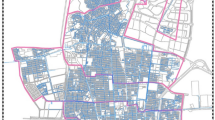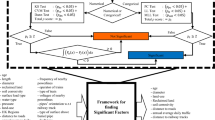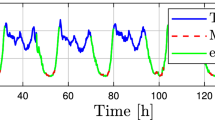Abstract
To reduce the amount of water wastage caused by leakage, the utilities have to monitor and detect leakage of water distribution networks periodically. In order to identify leaking pipelines efficiently when limited resources are available, a cluster identification method (CIM) is proposed to establish a priority for leakage detection and to assess whether spatial clusters of high failure-prone areas exist. The proposed CIM evaluates the difference between the observed data and simulated trials to determine the statistical significance of each cluster; a method previously applied only in epidemiology studies to assess the occurrence probabilities of rare diseases for spatial clusters. The CIM suggested in this study is the overlapping local case proportions (OLCP) that uses grids to scope the entire area and then to simulate the number of failures in the neighborhood of each grid. The simulated failure ratios are then compared with the existing records to determine the statistical significance. The statistical significance represents the potential of the grid requiring further leakage detection. Three failure probability estimation methods, including local average, global average, and empirical equation, are utilized to analyze the suitability of the OLCP for use with various probability inputs. A case study in the central region of Taiwan was implemented to demonstrate the applicability of the proposed method. The results indicate that the rate of failure in the following year found within the spatial clusters determined by the OLCP was twice the average amount and thus provided valuable information used to prioritize the pipelines for further inspection.








Similar content being viewed by others
Explore related subjects
Discover the latest articles and news from researchers in related subjects, suggested using machine learning.References
Alvisi S, Franchini M (2005) Rehabilitation scheduling of water distribution systems based on multi-objective genetic algorithms. In: Paper presented at the proceedings of the eight international conference on computing and control for the water industry, University of Exeter, UK
Best NG, Ickstadt K, Wolpert RL, Briggs DJ (2001) Chap 22 combining models of health and exposure data: the SAVIAH study. In: Elliott P, Wakefield J, Best N, Briggs D (eds) Spatial epidemiology: methods and applications. Oxford University Press, NYC
Charalambous B (2005) Experiences in DMA redesign at the Water Board of Lemesos, Cyprus. In: Paper presented at the leakage 2005 conference proceedings
Chuang L-W (2008) District metering area partition procedure and optimization model for water distribution network leakage detection. National Chiao-Tung University, Taiwan
Dandy GC, Engelhardt MO (2006) Multi-objective trade-offs between cost and reliability in the replacement of water mains. J Water Resour Plan Manag 132(2):79–88
Department of Geography, The University of Iowa (2007) DMAP IV. http://www.uiowa.edu/~gishlth/DMAP4
Farley M, Trow S (2003) Losses in water distribution networks: a practitioners’ guide to assessment, monitoring and control. International water association
Kleiner Y, Adams BJ, Rogers JS (1998) Long-term planning methodology for water distribution system rehabilitation. Water Resour Res 34(8):2039–2051
Kulldorff M, Nagarwalla N (1995) Spatial disease clusters: detection and inference. Stat Med 14:799–810
Mondéjar-Jiménez J, Vargas-Vargas M, Segarra-Oña M, Peiró-Signes A (2013) Categorizing variables affecting the proactive environmental orientation of firms. Int J Environ Res 7(2):495–500
Openshaw S, Charlton M, Craft AW, Birch J (1988) Investigation of leukaemia clusters by use of a geographical analysis machine. The Lancet 331(8580):272–273
Rushton G, Lolonis P (1996) Exploratory spatial analysis of birth defect rates in an urban population. Stat Med 15:717–726
Smith GH (2001) Disease cluster detection methods: the impact of choice of shape on the power of statistical tests. http://www.cobblestoneconcepts.com/ucgis2summer/smith/SMITH.HTM.2013
Su YC, Mays LW, Duan N, Lansey KE (1987) Reliability based optimization model for water distribution systems. J Hydraul Eng (ASCE) 114(12):1539–1556
Walski TM, Pelliccia A (1982) Economic analysis of water main breaks. J Am Water Works Assoc 74(3):140–147
Yiannakoulias N (2009) Using population attributable risk to understand geographic disease clusters. Health Place 15(4):1142–1148. doi:10.1016/j.healthplace.2009.07.001
Acknowledgments
The writers would like to thank the National Science Council of Taiwan, the Republic of China, for financially supporting this research under Contract No. NSC 101-2211-E-324-012. The writers would also like to express special thanks to Dr. Qiang Cai for his developing DMAP IV and assistance in helping the authors use the program in this study.
Author information
Authors and Affiliations
Corresponding author
Rights and permissions
About this article
Cite this article
Lin, HY., Lin, BW., Li, PH. et al. The application of the cluster identification method for the detection of leakages in water distribution networks. Int. J. Environ. Sci. Technol. 12, 2687–2696 (2015). https://doi.org/10.1007/s13762-014-0666-0
Received:
Revised:
Accepted:
Published:
Issue Date:
DOI: https://doi.org/10.1007/s13762-014-0666-0




